Pest Reports
Read MOFGA’s Pest Reports Fact Sheet Series
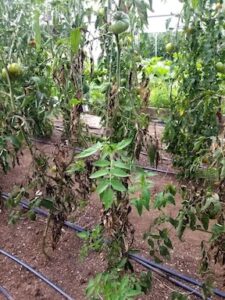
Stemphylium Gray Leaf Spot of Tomato
Pest: Stemphylium Gray Leaf Spot of Tomato Gray leaf spot can be caused by several fungal species in the Stemphylium genus. Stemphylium solani and S.
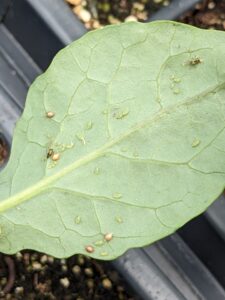
Aphids
Pest: Aphids Aphids are perhaps the soft-bodied insect pest most well-known to both farmers and gardeners. There are many different species of aphids, but green
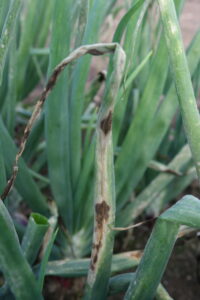
Foliar Diseases of Alliums
Disease(s): Common Foliar Diseases of Alliums This fact sheet discusses botrytis leaf spot (Botrytis squamosa), purple blotch (Alternaria porri), stemphylium leaf blight (Stemphylium vesicarium) and
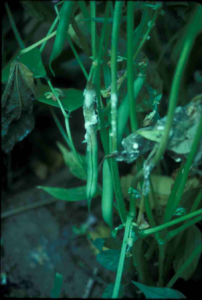
White Mold
Pest: White mold (Sclerotinia sclerotium) Pest/disease lifecycle, most common damage symptoms and crops affected: White mold (Sclerotinia sclerotium) is a widespread disease of over 300
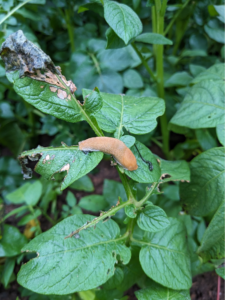
Slugs and Snails
Pest: Slugs and Snails Pest/disease identification and lifecycle, most common damage symptoms and crops affected: Land slugs and snails are closely related mollusks, known together
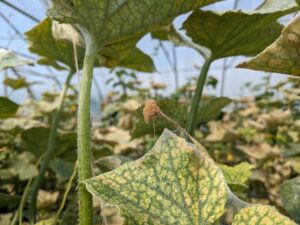
Two-Spotted Spider Mites
Pest: Two-spotted spider mites (Tetryanchus urticae) Pest/disease identification and lifecycle, most common damage symptoms and crops affected: Two-spotted spider mites are the most common mite
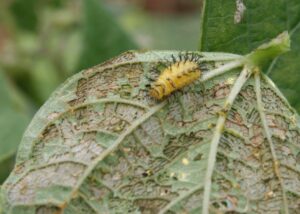
Mexican Bean Beetle
Pest: Mexican bean beetle (Epilachna varivestis) Pest/disease identification and lifecycle, most common damage symptoms and crops affected: If Mexican bean beetles have historically been a

Tomato Brown Rugose Fruit Virus
Pest: Tomato Brown Rugose Fruit Virus (ToBRFV) Disease identification: Tomato brown rugose fruit virus, otherwise referred to as ToBRFV, is a highly virulent and aggressive
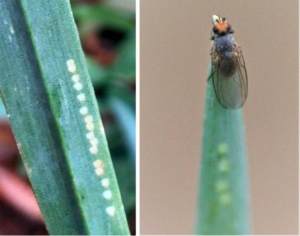
Allium Leafminer
Pest: Allium Leafminer (Phytomyza gymnostoma) Pest/disease identification and lifecycle, most common damage symptoms and crops affected: Allium, or onion, leafminer (ALM) is an invasive pest
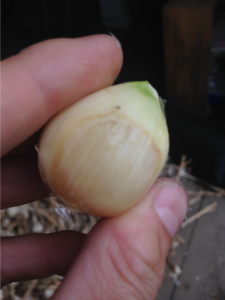
Waxy Breakdown of Garlic
Condition: Waxy Breakdown (an abiotic disorder) Pest/disease identification and lifecycle, most common damage symptoms and crops affected: Waxy breakdown of garlic is a physiological condition
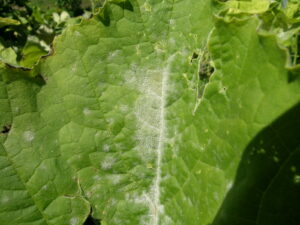
Powdery Mildew of Cucurbits
Disease: Powdery Mildew of Cucurbits (Podosphaera xanthii and Erysiphe cichoracearum) Pest/disease identification and lifecycle, most common damage symptoms and crops affected: Management options: Powdery mildew
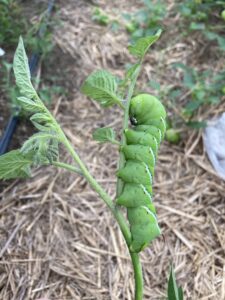
Hornworms
Pest: Hornworms (Manduca sexta, M. quinquemaculata) Pest/disease identification and lifecycle, most common damage symptoms and crops affected: Hornworms are probably the most destructive insect that
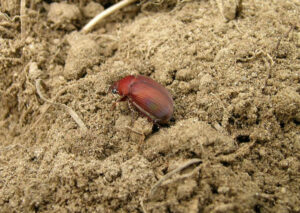
Scarab beetles
Pest: Scarab beetles (Asiatic Garden, Japanese, Oriental, Chafers) Pest/disease identification and lifecycle, most common damage symptoms and crops affected: There are several species of scarab

Basil Downy Mildew
Pest: Basil Downy Mildew (Peronospora belbahrii) Pest/disease identification and lifecycle, most common damage symptoms and crops affected: Downy mildew of basil was first reported in
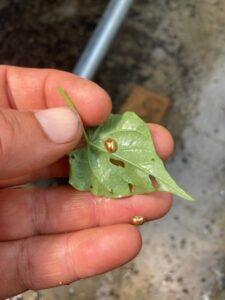
Clavate and Golden Tortoise Beetles
Pest: Tortoise beetle (species in the Cassidinae subfamily) Pest/disease identification and lifecycle, most common damage symptoms and crops affected: There are many species of tortoise
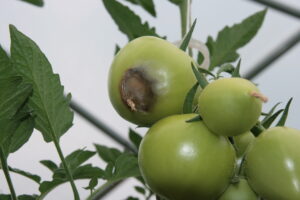
Blossom End Rot
Blossom End Rot Blossom end rot is a familiar sight for many tomato growers, but it can affect other crops as well, such as peppers
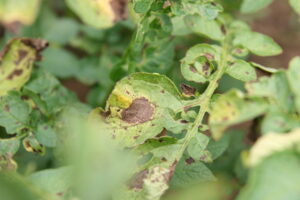
Early Blight
Disease: Early blight on tomato (Alternaria) Pest/disease identification and lifecycle, most common damage symptoms and crops affected: Early blight is a serious problem in tomatoes
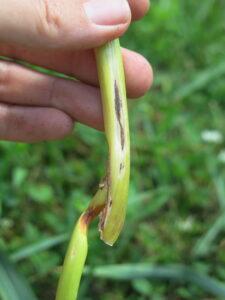
Garlic Anthracnose
Pest: Anthracnose (Colletotrichum fioriniae) Pest/disease identification and lifecycle, most common damage symptoms and crops affected: The fungus pathogen that is responsible for anthracnose on garlic
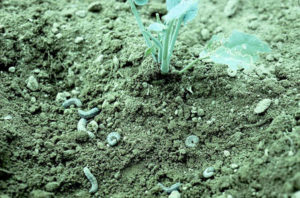
Cutworms
Pest: Cutworms (many species) Pest/disease identification and lifecycle, most common damage symptoms and crops affected: Cutworms are occasional pests of many crops early in the
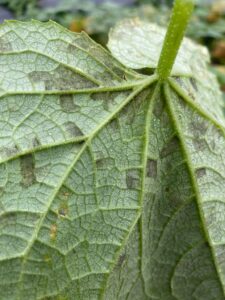
Cucurbit Downy Mildew
Pest: Cucurbit downy mildew (Pseudoperonospora cubensis) Pest/disease identification and lifecycle, most common damage symptoms and crops affected: Cucurbit downy mildew can be very destructive of
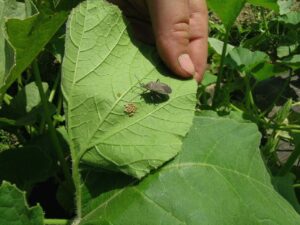
Squash Bug
Pest: Squash Bug (Anasa tristis) Pest identification and lifecycle, most common symptoms and crops affected: Squash bugs are serious pests of pumpkins and squash throughout
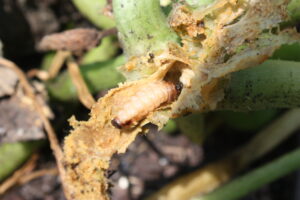
Squash Vine Borer
Pest: Squash vine borer (Melittia cucurbitae) Pest identification and lifecycle, most common symptoms and crops affected: Squash vine borer moths are day-flying moths with a
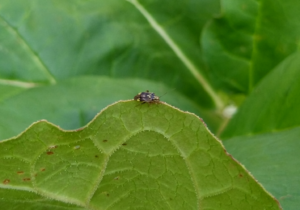
Tarnished Plant Bug and Four-Lined Plant Bug
Pests: Tarnished Plant Bug (Lygus lineolaris) and Four-Lined Plant Bug (Poecilocapsus lineatus) Pest identification and lifecycle, most common symptoms and crops affected: The tarnished plant
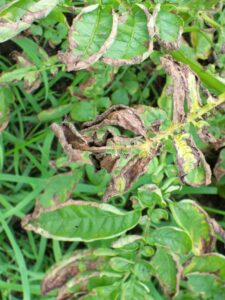
Potato Leafhoppers
Pest: Potato Leafhoppers (Empoasca fabae) Pest identification and lifecycle, most common symptoms and crops affected: The potato leafhopper has been arriving here in New England
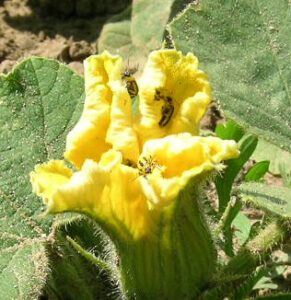
Striped Cucumber Beetle
Pest: Striped cucumber beetle (Acalymma vittatum) Pest/disease identification and lifecycle, most common damage symptoms and crops affected: Striped cucumber beetle is our most serious early-season
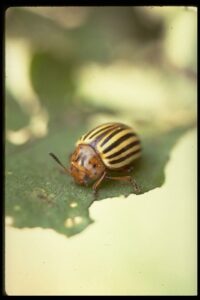
Colorado Potato Beetle
Pest: Colorado Potato Beetle (Leptinotarsa decemlineata) Pest identification and lifecycle, most common symptoms and crops affected: As with most other insects and plants, there is
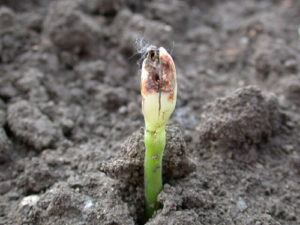
Seedcorn Maggot and Other Maggots
Pests: Seedcorn maggot (Hylemya platura), Onion maggot (Delia antiqua), Cabbage maggot (Delia radicum) Pest identification and lifecycle, most common symptoms and crops affected: Seedcorn maggot

Seedling Problems
In the early spring, when most plants are still in greenhouses — a much more controlled setting than gardens and fields — a lot of
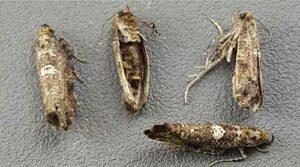
Leek Moth
Pests: Leek Moth (Acrolepiopsis assectella) Pest/disease identification and lifecycle, most common damage symptoms and crops affected: Leek moth is a newer invasive pest of allium
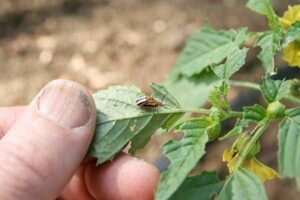
Three-Lined Potato Beetle
Pests: Three-Lined Potato Beetle (Lema daturaphila) Pest/disease identification and lifecycle, most common damage symptoms and crops affected: The favorite foods of the three-lined potato beetle

Spinach Leafminer and Beet Leafminer
Pests: Spinach leafminer (Pegomya hyoscyami), Beet leafminer (Pegomya betae) Pest/disease identification and lifecycle, most common symptoms and crops affected: These closely related species of leafminer
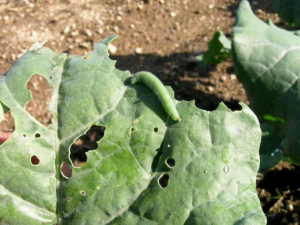
Cabbageworm
Pests: Imported Cabbageworm (Pieris rapae), Diamondback Moth (Platella zylostella), Cabbage Looper (Trichoplusia ni) The first sign of imported cabbageworm is typically one or more white
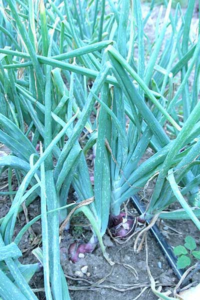
Onion Thrips
Pest: Onion Thrips (Thrips tabaci) Pest/disease Identification and lifecycle, most common symptoms and crops affected: Onion thrips are active already, and if they have been
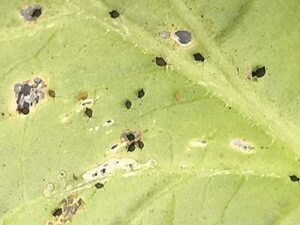
Garden Springtails
Pest: Garden Springtails (Collembolla) Pest/disease identification and lifecycle, most common symptoms and crops affected: Springtails are a very diverse group of soil dwelling arthropods, that
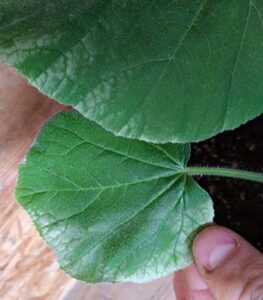
Sunscald/Windwhip
Pest/disease identification and lifecycle, most common symptoms and crops affected: Plants that have not yet been hardened off thoroughly, or can’t get all the water
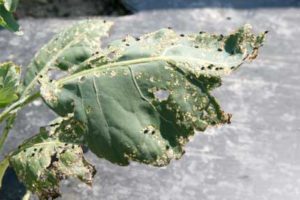
Flea Beetles
Pests: Crucifer Flea Beetle (Phyllotreta cruciferae), Striped Flea Beetle (Phyllotreta striolata), and Solanaceous flea beetles (in the genus Epitrix — E. cucumeris and E. fuscula)
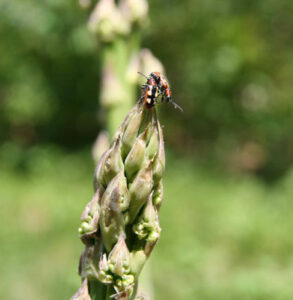
Asparagus Beetle
Pest: Asparagus Beetle, Common (Crioceris asparigi) and Spotted (Crioceris duodecimpunctata) Pest identification and lifecycle, most common symptoms and crops affected: Common Asparagus Beetle (Crioceris asparigi) Blue-black,
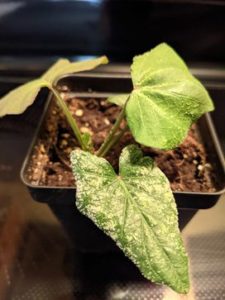
Edema
Pest: Edema Pest/disease identification and lifecycle, most common symptoms and crops affected: Edema usually shows up on tomato seedlings when they have been waiting through
Floating Row Cover Foils Potato Pests
By Jonathan Mitschele In late July 2017 I discovered that my potato plants were not doing well. Leaves were yellowing and the plants were not growing as expected. Suspecting some sort of blight, I sent photos to Eric Sideman at MOFGA. He thought the problem was potato leafhoppers and referred me to a MOFGA pest
Dealing with Pest Animals in the Organic Garden
By Will Bonsall Note: Certified organic producers should check with their certifier before using any pesticides (including pest repellents) not mentioned on their organic farm plan. When using pesticides on crops grown commercially and intended for human consumption, an applicator’s license may be required. See https://www.maine.gov/dacf/php/pesticides/applicators/licensing.html. One of the main problems with growing the foods we
A Frustrating New Brassica Pest The Swede Midge
Swede midge larvae, circled Broccoli leaves contorted by swede midge larvae feeding Swede midge damage in broccoli Multiple heads of Veronica cauliflower – a result of swede midge feeding By Caleb Goossen, Ph.D. Photos by David Fuller Over the coming years, farmers and home gardeners in Maine will likely encounter damage on their brassica plants
Tend to browntail moth webs now
Browntail moths. English photo March 1, 2020 If you find browntail moth webs within reach, clip them by mid-April and destroy the webs by soaking them in soapy water or burning them. Winter is the best time to clip webs due to the low risk of exposure to the caterpillars’ toxic hairs, due to caterpillar dormancy,
Animal Pests in the Garden
Without a contiguous perimeter of metal deer fencing that is at least 8 feet tall, these animals are likely to enjoy your crops. Anyone can set a live trap anytime and relocate woodchucks, raccoons or skunks. By Caleb Goossen, Ph.D. The three most common mammal pests that gardeners ask me about are deer,
Another Maine Area Affected by Leek Moth
Leek moth cocoon Adult leek moths A leek plant destroyed by leek moth larvae. By David Fuller Photos by the author Leek moth was identified in 2017 by Cooperative Extension in Jackman. Those populations have subsequently migrated south to Long Pond Township, a distance of about 10 miles. Now leek moth has also been found in Rangeley
Controlling Pest Insects in the Organic Garden
One way to manage pest insects is to create habitat in your garden for beneficial insects such as ladybugs. Oxalic acid in the leaf blades (not petioles) of rhubarb can help repel flea beetles. Row cover, although a synthetic material, can last several years with care. An infusion of tansy, growing here with goldenrod, may
Managing Cabbage Aphids
Cabbage aphids on kale growing in a tunnel. Photo by Eric Sideman Habitat plants flowering among brussels sprouts. Photo by Becky Sideman By Eric Sideman, Ph.D. Although it may seem so, the cabbage aphid is not a new pest. My favorite discussion of this pest is in a 1928 text called “Destructive and Useful Insects, Their Habits and
Leek Moth
Leek moth. Photo by David Fuller Leek moth larvae on the inside of an onion leaf. Photo by David Fuller By Dave Fuller, Agriculture and Non-Timber Forest Products Professional, UMaine Cooperative Extension, Franklin County Leek moth (Acrolepiopsis assectella Zeller), a very destructive pest of all of the Allium genus, was first found in Jackman, Maine,
Next Years Pest Management Begins Now
Seedcorn maggots feeding on young spinach. Seedcorn maggots in soil amended with soy meal. European corn borer overwintering in a corn stalk. Early blight on lower leaves of tomatoes. Close-up of early blight on tomato. Late blight on potato. By Eric Sideman, Ph.D. Fall garden care is the beginning of spring garden pest management. Many
Beneficial Insects
Cocoons of a wasp that parasitized a tomato hornworm. Eric Sideman photo Beneficial insects are part of complicated relationships in ecosystems, and we are just beginning to understand those relationships, said Kathy Murray, Ph.D., an entomologist and Integrated Pest Management (IPM) program coordinator with the Maine Department of Agriculture, Conservation and Forestry. Murray is also
Row Covers
By Kerstin Tengeler I am an organic vegetable farmer in St. Lawrence County in upstate New York. My partners and I use row covers on our 4-acre farm to extend our growing season and to protect our crops from insects and deer. Because minimizing the use of plastics that end up in landfills is important
Leafhoppers Again?
These apple leafhopper nymphs and adult show the shape of the insect. Potato leafhoppers are the same shape but greenish in color. Photo courtesy of Don Barry, Univ. of Maine Pest Management Office. By Eric Sideman, Ph.D. MOFGA’s Director of Technical Services Last year towards the end of June and early July, I started to
Drosophila
Figure 1 – The female spotted wing Drosophila (fruit fly), a new pest in New England, uses her serrated ovipositor to make a hole in sound fruit and lay her eggs, which develop into larvae in the fruit. Photo courtesy of Alan Eaton of the University of N.H. By Eric Sideman, Ph.D. I am usually
Potato Beetle
By Eric Sideman, Ph.D. Director of Technical Services, MOFGA I can understand farmers who tell me they’re tired of hearing about the new USDA Rule and the regulation of organic vegetable production. I have said many times that the new rule is really 99% similar to MOFGA’s old standards, and I still claim that. Then
Pest Control
A Natural System Just Dying for Balance By Jean English Michael Zuck gave an inspiring talk at MOFGA and Cooperative Extension’s Farmer to Farmer Conference about using teosinte and other plants as “banker plants” in greenhouses – plants that support pests that, in turn, support beneficial insects. English photo. Michael Zuck’s fascination with nature’s multiple
Sideman Summer 09
By Eric Sideman, Ph.D. Does summertime bode many afternoon hours in the hammock thinking about what’s good in the garden to go with that hamburger hot off the grill – or hours of worrying what could go wrong in that garden, which looks so good this early in the season? Balancing fun with fret is
Pesticide Regs
The OMRI categories that may include pesticides are: amino acids Bacillus thuringiensis Beauveria bassiana biological controls boric acid botanical pesticides calcium polysulfide copper products corn gluten diatomaceous earth enzymes nonsynthetic fungicides gibberellic acid nonsynthetic herbicides hydrogen peroxide inoculants lime sulfur limonene neem cake and extract nonsynthetic nematicides narrow range oils nonsynthetic oils pheromones potassium bicarbonate
Helping Plants
Toki Oshima illustration. By Jan Suszkiw, Agricultural Research Service Information Staff People aren’t the only ones to benefit from salicylic acid, the active ingredient in aspirin. Spraying this naturally occurring compound onto some plants triggers natural defenses that keep harmful fungi, bacteria and viruses at bay. Plants have always had some means to defend themselves,
Garlic Oil
An oil made from garlic can be mixed with a percentage of bird seed and fed to starlings in areas that you want them to avoid. After a taste of the garlic oil-impregnated seed, they’ll do just that. Photograph from Corel Corporation, used with permission. by John K. Borchardt Garlic repels more than just vampires.
Pests
Squash bug. Photo credit: 1 By Eric Sideman, Ph.D. Fall chores are my favorites. At no other time do I have more hope for a successful garden than the fall before. Autumn is even better than spring, especially last spring when we all realized very early in April that it was not going to be
Carrot Rust Fly
The larva of the carrot rust fly is a maggot that tunnels into carrots. Photos by Eric Sideman. by Eric Sideman, Ph.D. I have lived in the same house in Greene, Maine, for over 20 years, and the carrot rust fly has been a problem only one of those years. But it was awful that
